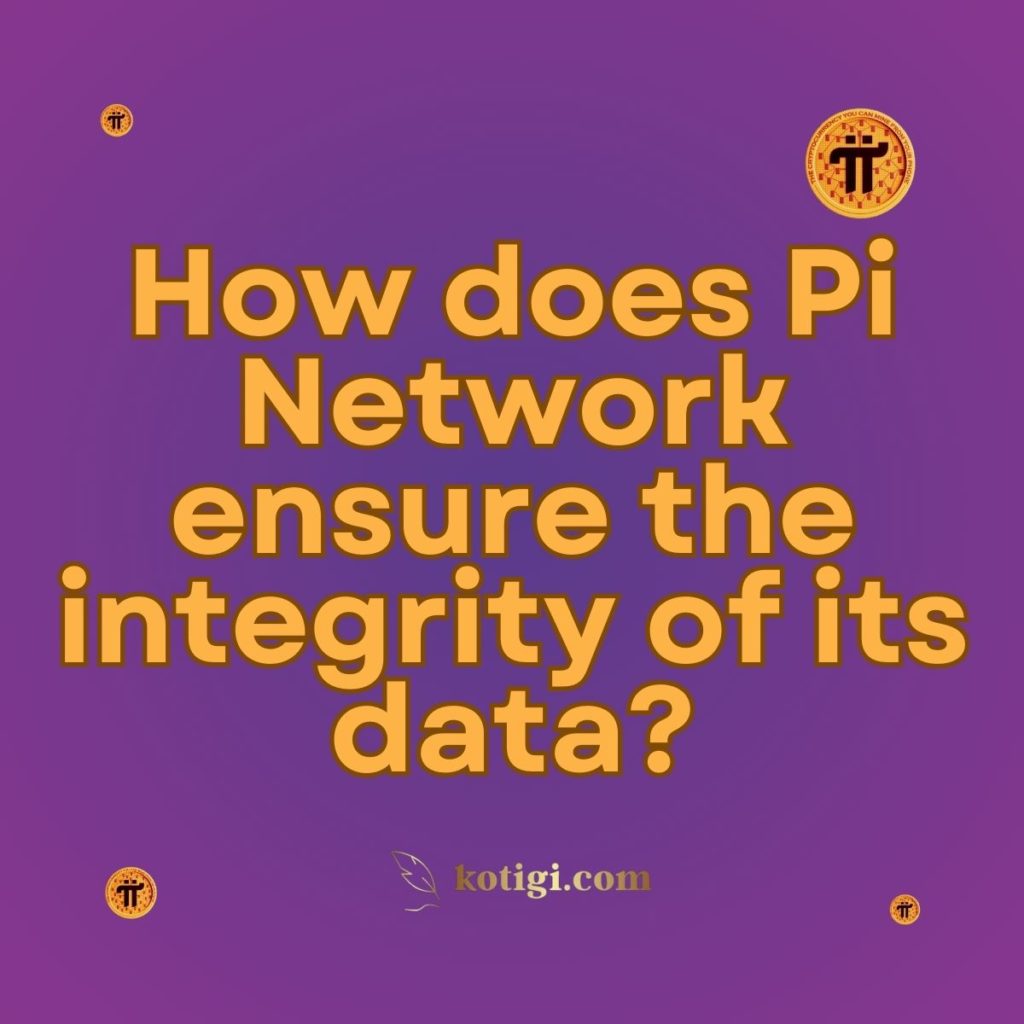
How does Pi Network ensure the integrity of its data?
Pi Network employs a combination of decentralized consensus mechanisms, cryptographic techniques, and community validation to maintain the integrity of its data. This multi-layered approach safeguards against tampering and ensures reliable transaction records within the network.
Introduction
In the rapidly evolving world of blockchain technology, ensuring data integrity is critical for establishing trust and functionality within any cryptocurrency network. Data integrity refers to the accuracy, consistency, and reliability of data over its lifecycle. For a cryptocurrency like Pi Network, maintaining this integrity is essential not only for user confidence but also for the overall health of the ecosystem. This article delves into how Pi Network addresses data integrity through innovative technologies and community engagement.
Understanding Data Integrity in Blockchain
What is Data Integrity?
Data integrity encompasses the maintenance of data accuracy and consistency. In the context of blockchain, it ensures that the data recorded cannot be altered or corrupted without detection.
- Key Principles of Data Integrity
The key principles include accuracy, consistency, completeness, and validity. These principles help ensure that data remains trustworthy. - Importance of Integrity
High data integrity is crucial for trust in financial transactions, user privacy, and the overall reliability of the blockchain network. - Types of Data Integrity
- Physical Integrity: Protects against data loss due to physical failures.
- Logical Integrity: Ensures that data remains accurate and consistent within its context.
- Temporal Integrity: Guarantees that the data is up-to-date and reflects the current state of the system.
Challenges to Data Integrity in Blockchain
- Tampering and Fraud
One of the most significant threats to data integrity is unauthorized access, which can lead to data manipulation. - Centralization Risks
In centralized systems, a single point of failure can compromise data integrity, highlighting the need for decentralized solutions. - Human Error
Mistakes in data entry or processing can undermine integrity, necessitating robust mechanisms to detect and correct errors. - Cybersecurity Threats
Increasingly sophisticated cyberattacks pose ongoing risks to the integrity of blockchain systems, making data security a top priority.
Pi Network’s Approach to Data Integrity
Decentralized Consensus Mechanism
Pi Network uses the Federated Byzantine Agreement (FBA) as its consensus mechanism, which plays a vital role in ensuring data integrity.
- Understanding Federated Byzantine Agreement (FBA)
FBA allows nodes in the network to reach consensus on the state of the blockchain without relying on energy-intensive mining. This mechanism fosters quick and reliable transaction validation while ensuring data remains intact. - Benefits of FBA
- Energy Efficiency: FBA consumes far less energy than traditional mining methods, making it a sustainable option.
- Rapid Consensus: The mechanism allows for quicker consensus, which is crucial for real-time transactions.
- Improved Security: The decentralized nature of FBA protects against single points of failure, enhancing data security.
- Resilience Against Attacks
By distributing the decision-making process across multiple nodes, Pi Network becomes more resilient to various attacks aimed at corrupting data.
Cryptographic Techniques
Cryptographic methods are foundational to ensuring data integrity within Pi Network.
- Hash Functions
Cryptographic hash functions convert data into fixed-size hashes, creating a unique fingerprint. Any change to the original data will result in a different hash, making it easy to detect unauthorized alterations. - Digital Signatures
Digital signatures provide authentication for transactions. They ensure that only authorized users can initiate changes, verifying the identity of the sender and the integrity of the message. - Data Encryption
Encryption techniques protect sensitive information during transmission and storage, ensuring that only authorized users can access the data. - Blockchain Immutability
Once data is recorded on the blockchain, it becomes nearly impossible to alter without detection, thanks to the combination of hashing and cryptographic techniques.
Community Validation and Trust Circles
Role of Community in Data Integrity
The Pi Network places significant emphasis on community engagement for data validation.
- Trust Circles
Trust circles consist of groups of users who validate transactions based on mutual trust. This system enhances the reliability of data across the network, as transactions are scrutinized by trusted peers before approval. - Peer Review Process
Transactions undergo a peer review process, where community members check for discrepancies. This collaborative effort reinforces data accuracy. - Collective Responsibility
Distributing the responsibility of data validation reduces the risk of individual errors or malicious acts affecting data integrity. The community’s active participation fosters a culture of accountability.
Encouraging User Engagement
- Incentives for Participation
Pi Network incentivizes users to engage in the validation process through rewards, promoting a sense of ownership and accountability within the community. - Educational Resources
Providing resources that educate users about their roles and responsibilities enhances their understanding and capability to maintain data integrity. - Feedback Mechanisms
The network encourages user feedback, which can help identify vulnerabilities or areas needing improvement in data management practices.
Mechanisms for Detecting and Correcting Errors
Error Detection Techniques
- Transaction Auditing
Regular audits of transactions help identify discrepancies and maintain overall data integrity. Audits ensure that any irregularities are detected early. - Automated Monitoring
The network utilizes automated systems to monitor data changes in real-time, flagging any unusual activities for further investigation. - Anomaly Detection Algorithms
Advanced algorithms can identify patterns that deviate from normal operations, alerting administrators to potential issues before they escalate.
Error Correction Protocols
- Rollback Procedures
In the event of detected fraud or errors, rollback procedures allow the network to revert to a previous state, restoring data integrity. This safety net is essential for maintaining trust among users. - Collaborative Correction
The community can collaborate to correct errors, reinforcing the collective responsibility for maintaining accurate data. When users work together, the chances of effective correction increase. - Transparent Reporting
Transparency in reporting errors fosters trust among users. By openly discussing issues and solutions, Pi Network builds a stronger community.
Future Enhancements for Data Integrity
Continuous Improvement Strategies
- Ongoing Research and Development
Pi Network is committed to ongoing research and development to enhance its data integrity mechanisms and adapt to emerging threats. Continuous innovation is key to staying ahead of potential vulnerabilities. - User Feedback Integration
Integrating user feedback into development plans ensures that the network addresses real-world concerns related to data integrity. Listening to users helps identify practical solutions. - Partnerships with Security Experts
Collaborating with cybersecurity experts can help identify potential vulnerabilities and implement best practices for data integrity. Partnerships are vital for building a secure ecosystem.
Scaling Integrity Solutions
- Adapting to Growth
As the network grows, ensuring data integrity at scale will be a priority, requiring scalable solutions that can handle increased data flow. - Technological Innovations
Embracing innovative technologies can enhance the effectiveness of existing integrity mechanisms. The rapid pace of technological advancement necessitates continual adaptation. - Community Expansion
Expanding the community will enhance data validation capabilities and further reinforce data integrity. A larger community contributes to a more robust validation process.
Comparative Analysis: Pi Network vs. Other Blockchain Technologies
Comparison of Consensus Mechanisms
| Blockchain | Consensus Mechanism | Energy Consumption | Data Integrity Measures |
|---|---|---|---|
| Pi Network | Federated Byzantine Agreement | Minimal | Cryptographic techniques, trust circles |
| Bitcoin | Proof of Work (PoW) | High | Hashing, digital signatures, mining-based validation |
| Ethereum | Transitioning from PoW to PoS | Moderate to High | Hashing, digital signatures, mining-based validation |
| Cardano | Proof of Stake (PoS) | Low | Smart contracts, staking validation |
Key Differences in Data Integrity Approaches
- Energy Efficiency: Pi Network’s FBA mechanism allows for low energy consumption, making it more sustainable than Bitcoin’s PoW model, which requires substantial energy resources.
- Community Engagement: Pi Network’s emphasis on community validation through trust circles sets it apart from other blockchains, where validation is often limited to miners or stakers.
- Adaptability: Pi Network’s continuous improvement strategies allow it to adapt to emerging challenges more readily than some established blockchains.
Conclusion
Ensuring the integrity of data is a critical component of any blockchain project, and Pi Network employs a multifaceted approach to achieve this goal. Through decentralized consensus mechanisms, cryptographic techniques, and active community engagement, Pi Network maintains a secure and reliable network for its users.
As the cryptocurrency landscape continues to evolve, Pi Network’s commitment to data integrity will be vital in fostering trust and enabling sustainable growth. By continuously improving its strategies and adapting to emerging challenges, Pi Network is well-positioned to ensure the integrity of its data in the years to come.
Key Takeaways
- Data integrity is crucial for trust in blockchain technology and encompasses accuracy, consistency, and reliability.
- Pi Network employs a decentralized consensus mechanism (FBA) to enhance data integrity while minimizing energy consumption.
- Cryptographic techniques, such as hash functions and digital signatures, are vital for securing data against tampering.
- Community validation through trust circles fosters accountability and improves the accuracy of data.
- Ongoing research, user feedback, and technological advancements are essential for maintaining and improving data integrity.




